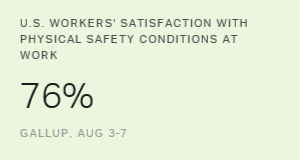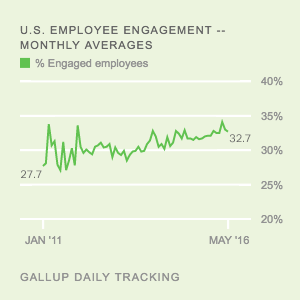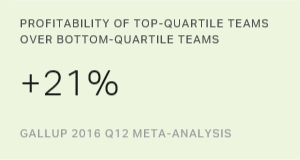Story Highlights
- Workers' satisfaction with various job dimensions has improved in 2016
- Highest satisfaction is with safety and relations with coworkers
- Workers generally least satisfied with stress, benefits and pay
PRINCETON, N.J. -- U.S. workers continue to be most positive about their physical safety on the job, their relations with coworkers, their flexibility of hours and their job security. Workers are least satisfied with other aspects of their jobs, including their health benefits, the money they earn, their chances for promotion, retirement plans and on-the-job stress -- the last of which is at the bottom of the list. From last year to this year, workers have become more satisfied with most aspects of their jobs.
| 2015 | 2016 | Change over past year | |||||||||||||||||||||||||||||||||||||||||||||||||||||||||||||||||||||||||||||||||||||||||||||||||
|---|---|---|---|---|---|---|---|---|---|---|---|---|---|---|---|---|---|---|---|---|---|---|---|---|---|---|---|---|---|---|---|---|---|---|---|---|---|---|---|---|---|---|---|---|---|---|---|---|---|---|---|---|---|---|---|---|---|---|---|---|---|---|---|---|---|---|---|---|---|---|---|---|---|---|---|---|---|---|---|---|---|---|---|---|---|---|---|---|---|---|---|---|---|---|---|---|---|---|---|
| % | % | (pct. pts.) | |||||||||||||||||||||||||||||||||||||||||||||||||||||||||||||||||||||||||||||||||||||||||||||||||
| The physical safety conditions of your workplace | 70 | 76 | +6 | ||||||||||||||||||||||||||||||||||||||||||||||||||||||||||||||||||||||||||||||||||||||||||||||||
| Your relations with coworkers | 72 | 71 | -1 | ||||||||||||||||||||||||||||||||||||||||||||||||||||||||||||||||||||||||||||||||||||||||||||||||
| The flexibility of your hours | 58 | 67 | +9 | ||||||||||||||||||||||||||||||||||||||||||||||||||||||||||||||||||||||||||||||||||||||||||||||||
| Your job security | 57 | 65 | +8 | ||||||||||||||||||||||||||||||||||||||||||||||||||||||||||||||||||||||||||||||||||||||||||||||||
| Your boss or immediate supervisor | 54 | 61 | +7 | ||||||||||||||||||||||||||||||||||||||||||||||||||||||||||||||||||||||||||||||||||||||||||||||||
| The amount of work that is required of you | 53 | 58 | +5 | ||||||||||||||||||||||||||||||||||||||||||||||||||||||||||||||||||||||||||||||||||||||||||||||||
| The amount of vacation time you receive | 57 | 56 | -1 | ||||||||||||||||||||||||||||||||||||||||||||||||||||||||||||||||||||||||||||||||||||||||||||||||
| The recognition you receive at work for your work accomplishments | 45 | 55 | +10 | ||||||||||||||||||||||||||||||||||||||||||||||||||||||||||||||||||||||||||||||||||||||||||||||||
| The retirement plan your employer offers | 35 | 44 | +9 | ||||||||||||||||||||||||||||||||||||||||||||||||||||||||||||||||||||||||||||||||||||||||||||||||
| Your chances for promotion | 35 | 43 | +8 | ||||||||||||||||||||||||||||||||||||||||||||||||||||||||||||||||||||||||||||||||||||||||||||||||
| The amount of money you earn | 33 | 41 | +8 | ||||||||||||||||||||||||||||||||||||||||||||||||||||||||||||||||||||||||||||||||||||||||||||||||
| The health insurance benefits your employer offers | 40 | 37 | -3 | ||||||||||||||||||||||||||||||||||||||||||||||||||||||||||||||||||||||||||||||||||||||||||||||||
| The amount of on-the-job stress in your job | 28 | 34 | +6 | ||||||||||||||||||||||||||||||||||||||||||||||||||||||||||||||||||||||||||||||||||||||||||||||||
| Based on adults employed full or part time | |||||||||||||||||||||||||||||||||||||||||||||||||||||||||||||||||||||||||||||||||||||||||||||||||||
| Gallup | |||||||||||||||||||||||||||||||||||||||||||||||||||||||||||||||||||||||||||||||||||||||||||||||||||
These results are from Gallup's annual Work and Education survey, conducted Aug 3-7. In that survey, U.S. workers convey increased levels of contentment with their work or workplace: Satisfaction with 10 of the 13 job-related aspects measured has edged up from 2015. This trend coincides with a recent uptick in "good jobs" -- the percentage of Americans who work full time for an employer.
Workers' Satisfaction With Tangible Benefits Up Over Time
Workers' increased satisfaction this year with tangible benefits, such as the amount of money they earn and retirement benefits, is part of a long-term trend. Based on three-year rolling averages beginning in 2003, 26% of workers were completely satisfied with the amount of money they earned between 2001 and 2003, while 35% have been satisfied over the past three years, including 41% in 2016. Satisfaction with retirement plans has followed the same pattern.
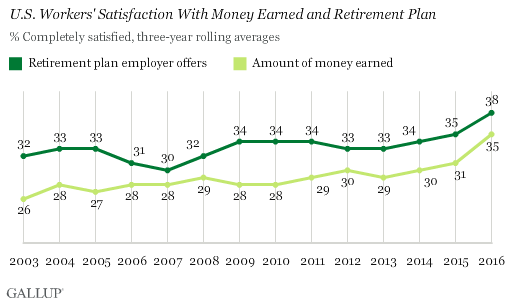
This rise in worker satisfaction with tangible benefits in the workplace coincides with government economic data showing that wages have risen by 2.6% over the past 12 months, Gallup data showing that the majority of workers say their pay has gotten better in recent years, and the increase in Gallup's "good jobs" measure.
Workers' satisfaction with vacation time has also edged up in recent years.
More Satisfaction With the Recognition Received at Work
Workers' satisfaction with the recognition they receive at work -- one of the less tangible aspects of work included in Gallup's trends -- improved more than any other dimension year over year and has shown a broad uptick over time since the early 2000s. The majority of workers (51%) interviewed over the past three years feel completely satisfied with the recognition they receive for their work, up from 42% in 2001 through 2003.
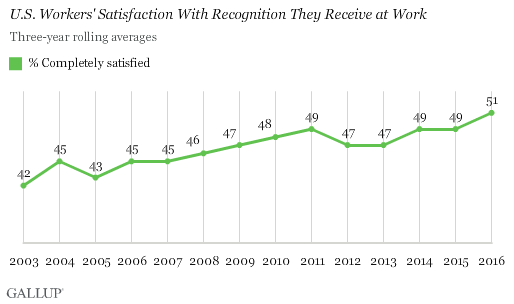
Worker Satisfaction and Worker Engagement
While satisfaction with work seems to be improving in the U.S., this trend needs to be viewed in the context of a different aspect of the workplace: engagement. Engaged employees -- a smaller subset of those who may be satisfied with their job -- are involved in and enthusiastic about their work and workplace. They are more likely to show up to work, are less likely to leave the organization, treat customers better and are more productive. Gallup finds that business units with an above-average number of highly engaged employees average 21% higher profitability than business units with few engaged employees.
As is the case for worker satisfaction, the percentage of engaged employees has grown slightly in recent years. But that leaves approximately two-thirds of U.S. employees whom Gallup classifies as either "not engaged" or "actively disengaged," which is significantly higher than the percentage who report being dissatisfied with aspects of their jobs. The result? Many workers are satisfied but are not engaged at work.
For example, while more U.S. workers in 2016 are reporting that they are completely satisfied with their retirement plans, flexible hours and pay, Gallup research shows that workers who are happy with these tangible benefits, but who are not engaged, produce little in return to their employers for these benefits. And past Gallup research has found that workers who are engaged have lower stress and higher well-being, regardless of hours worked, vacation time or flextime policies.
From an employer's perspective, this research shows that increasing workers' satisfaction with their workplace alone is not the formula to improve productivity, retention and output. Employers should also strive to have engaged employees -- those who are not just content with their job, but who are highly involved in and enthusiastic about it.
In an ideal world, American business and industry would have employees who are highly satisfied with all aspects of their job and, at the same time, highly engaged.
Employers can increase workers' satisfaction with their compensation by paying them fairly, can increase satisfaction with retirement plans by putting more money into 401(k) matches, and can boost satisfaction with vacation time by offering appropriate amounts so that employees are thriving in their overall lives.
Increasing engagement, on the surface, may seem like a less straightforward process. Gallup finds that boosting engagement involves focused efforts on complex elements that drive day-to-day performance -- including role clarity, opportunities to develop, and feedback and progress discussions. This type of focus on engagement, however, can have a powerful effect on the factors that matter most to an organization's performance management and human capital strategies. And, while about one-third of U.S. employees are engaged at work, many organizations have bucked this trend and have achieved more than double this rate -- particularly by identifying and developing managers with the skills to increase engagement effectively.
Survey Methods
Results for this Gallup poll are based on telephone interviews conducted Aug. 3-7, 2016, with a random sample of 521 adults employed full or part time, aged 18 and older, living in all 50 U.S. states and the District of Columbia. For results based on this sample, the margin of sampling error is ±6 percentage points at the 95% confidence level. All reported margins of sampling error include computed design effects for weighting.
Each sample of national adults includes a minimum quota of 60% cellphone respondents and 40% landline respondents, with additional minimum quotas by time zone within region. Landline and cellular telephone numbers are selected using random-digit-dial methods.
View survey methodology, complete question responses and trends.
Learn more about how the Gallup Poll Social Series works.
